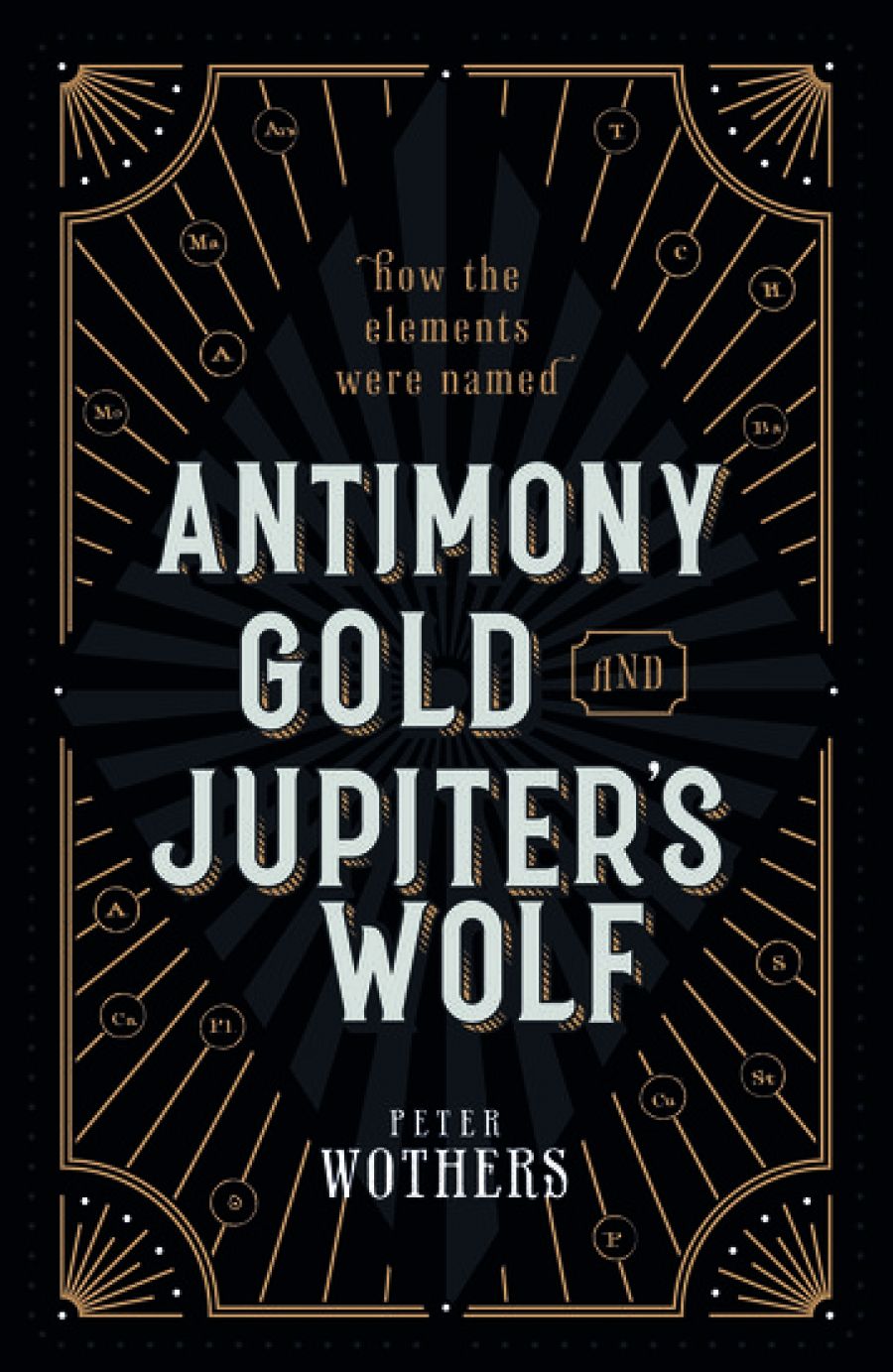
- Free Article: No
- Contents Category: Science and Technology
- Review Article: Yes
- Online Only: No
- Custom Highlight Text:
Imagine you’re trying to make sense of the universe five hundred years ago, when astronomers believe there are just seven visible ‘planets’ wandering about the Earth: the sun and moon plus Mercury to Saturn. Intriguingly, there are also seven known metals: gold, silver, copper, iron, tin, lead, and mercury. For hundreds of years there have been just seven known ‘planets’ and seven metals. Wouldn’t you be just a little tempted to see more than a coincidence here? Take gold, for example, which ‘does not react with anything in the air or the ground, and so retains its brilliance seemingly forever’: surely its power is similar to that of the ever-shining sun?
- Grid Image (300px * 250px):

- Book 1 Title: Antimony, Gold, and Jupiter’s Wolf
- Book 1 Subtitle: How the elements were named
- Book 1 Biblio: Oxford University Press, $40.95 hb, 280 pp
Then there’s fast-moving Mercury, an obvious match with the flowing metal originally known as ‘quicksilver’, while red Mars glows like red-hot iron, and so on. In Antimony, Gold, and Jupiter’s Wolf, Peter Wothers offers many tantalising titbits about the properties and etymologies of the first-known elements. But things become even more interesting when Copernicus transforms astronomy, new metals are discovered, and most of the coincidences that led to the ascription of sympathetic correspondences in alchemy and astrology are seen to be just that, coincidences.
Nevertheless, those early analogical attempts at finding order in the universe encoded a surprising amount of knowledge, much of it gained by miners. For example, Wothers reproduces an engraving from a 1617 text showing a wolf devouring a king, and a wolf standing in a fire from which the king re-emerges. At first glance, it looks like a moral allegory, but it’s something much more fascinating: an illustration of the process of using the metal antimony to purify gold. After heating, the antimony and other impurities evaporate, leaving pure gold, the only metal the ‘wolf’ – antimony – cannot devour.
 Wolfram (photograph via Wikimedia Commons)
Wolfram (photograph via Wikimedia Commons)
Then there’s ‘Jupiter’s wolf’, a name that arose from the ancient association between Jupiter and tin; the ‘wolf’ here is ‘wolfram’, a rock containing the element tungsten and often found with tin ore. Wolfram’s similar density to tin ore made the two difficult to separate, and wolfram also made tin brittler: it was said to ‘steal and devour’ the tin, ‘like a wolf’ – a metaphor that lives on in the symbol W for tungsten.
And so Wothers’s story of chemistry unfolds: Antimony, Gold, and Jupiter’s Wolf begins in antiquity, but it takes us right up to the 2016 announcement of names for the most recently discovered of the 118 currently known elements. Like most of the elements discovered in the past century, these last four were created in the lab – only eighty-eight stable elements occur naturally (plus a few unstable ones with short half-lives).
Not all these elements are metals, of course. The discovery and naming of the elemental gases making up air and water are particularly exciting, because air and water were long considered to be elements themselves. The evolution of our understanding of the true nature of these vital, ubiquitous substances – via the bold experiments and intellectual leaps of brilliant experimenters such as Antoine Lavoisier, Carl Wilhelm Scheele, and Henry Cavendish – makes gripping reading.
So does the discovery of helium, the first element that was initially discovered ‘off-world’ in the sun’s atmosphere. In deference to ancient practice it was named after Helios, the Greek sun god, and its identification was enabled by William Hyde Wollaston’s thrilling discovery of spectroscopy in 1802.
There are many other compelling stories in this, Wothers’s first book for the general reader (he’s a chemistry Teaching Fellow at Cambridge whose previous works are textbooks). His device of building the narrative around the naming of the chemical elements is an innovative and engaging way of telling an accessible story about chemistry.
The periodic table itself remains a shadowy presence, although the non-linear narrative gradually builds up a partial picture of why Dmitri Mendeleev grouped the elements the way he did, and how chemists worked out the atomic weights that gave the elements their places in his original table, and the atomic numbers used in today’s version. Still, if the book is short on certain specifics, and the naming of a few of the elements makes less than scintillating reading, overall Antimony, Gold, and Jupiter’s Wolf offers a host of intriguing historical details, colourful personalities, and valuable insights on the emergence of scientific thinking.
Among the extraordinary cast are two women. Polish-born Marie Curie discovered and named polonium and (with husband Pierre) radium at the close of the nineteenth century, while her French student Marguerite Perey discovered and named francium in 1939.
The dedication of these scientists was astounding. The Curies famously sifted through tonnes of ore to isolate a tenth of a gram of radium. The delightful William Ramsay discovered four noble gases hidden in the air (helium is the fifth) – an amazing feat, since xenon, for example, makes up just 0.0000087 per cent of the air. The prolific Humphry Davy discovered seven elements, but nearly lost an eye when heating a new substance (fluoric acid) that proved unexpectedly explosive. Indeed, the labours of many of the chemists discussed appear truly heroic as they tinkered, tested, and retested, showing just how much pure research it takes to produce useful new knowledge (politicians take note).
There’s so much more in this novel, deeply researched book. If you’ve ever wondered what’s in a name, Wothers shows that in chemistry the answer is clear: a great deal of fascinating folklore, science, and history.


Comments powered by CComment